Speight's Brewery

Beez Neez now Chy Whella
Big Bear and Pepe Millard
Mon 28 Jul 2014 22:57
|
Our Speight’s Brewery Tour
   We finished the
museum part of our tour in a room filled
with awards and medals. We particularly loved the gallery of
vehicles used to transport the beer around the country.
 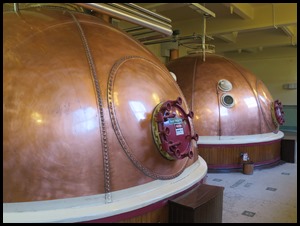  Beer begins with great quality water
so we began the brewery bit of our tour in the water
room. Speight’s brewery is very conveniently built over its own bore of
natural spring water. They have been using this natural mineral rich water for
their famous brew for well over a hundred years. The spring water is pumped from
the bore and stored in ‘Copper 2’, from there it is both sand and activated
carbon filtered just to ensure it contains no impurities, before being stored in
‘Copper 1’. This water is then used directly in brewing.
 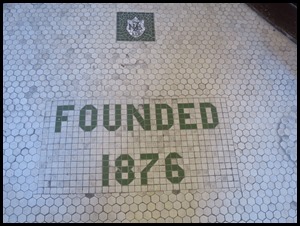  The original flooring and wall tiles are listed, many had to be removed
to enable the earthquake support walls to be added on the inner walls. The
company used this as an opportunity to bring in people with learning
difficulties. They set to work in a very dedicated and patient way. The removed
tiles were cleaned and replaced, just as they were.
  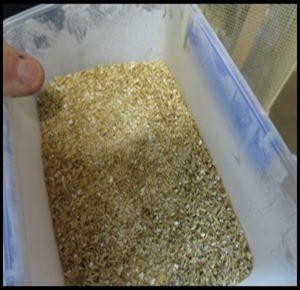 There’s an art to brewing a good
beer, the best natural raw ingredients with a bit of
science thrown in for good measure. The brew is then lovingly crafted through a
carefully controlled brewing process. The result is an outstanding drop. The raw
materials used at Speight’s are malted barley, sugar, hops yeast and of course
the above mentioned water. The barley is grown throughout South Island and the
Manawatu Plains on North Island, gathered and malted ready for use. Specialty
malts, such as crystal, amber, black caramalt and wheat malt are either found in
New Zealand or brought in from Australia and the UK. Prime New Zealand hops
grown in the Nelson District are used to give the essential bitterness and
aroma, the hallmarks of a good beer. Yeast, although not strictly an ingredient,
plays its part by converting the raw materials into beer.
   Bear showing an original hop collecting basket, in the days it was all done by hand.
What you cannot see in the picture is this enormous basket is really
heavy to begin with. The machine where the hops enter the
brewing system and the trusty hop.
Growing up in Kent, it was very
difficult to go too far before you were looking at miles of hop fields, then
owned by Whitbread and some by Guinness. Hops, when mentioned can go a bit Latin
and a bit sciency. The good old hop belongs to a small botanical family
Cannabinacae, comprising only two genres – Humulus and Cannibis. No funny ideas
though, not that stuff. Humulus is represented by two species the common
hop - humulus lupulis and the Japanese hop – humulis japonicas. The genus
Cannibis is solely represented by the hemp – cannibis sativa.
The hop is a hardy bugger - not a
swear word in these parts and used as a direct quote, as above. It’s an
herbaceous climbing plant that started off in Europe and Western Asia. The dried
cones contain lupulin, an aromatic, bittering compound that has been used for
centuries in beer making.
The New Zealand Hop Industry has been
running specialised plant breeding since the 1950’s. In 1968 New Zealand made
headlines in brewing circles. In response to international brewers’ demand for
seedless hops, the first country to commercially produce hops from triploid hop
cultivars. These cultivars lead the world in high alpha acid content together
with favourable characteristics.
Harvesting: In Nelson, harvest time
is from late February to early March, every year. After cutting, the hop vines
are brought to the picking machines, where the mature hop cones are stripped
from the vines, and put through a series of cleaning belts to remove leaves and
remnants of vine. Hop cones are dried through a combination of flat bed drying
and multi-floor kilns. The bulk of them are processed into pellets, vacuum
packed, then cooled stored until delivery to the brewery. That way they are kept
fresh.
 Each batch of malt is weighed and cleaned on the way up to the malt mill.
Then just before a ‘brew’ begins its crushed to form the ‘grist’. The usual
batch size is around three tonnes and needs to be crushed within a forty five
minute window. The crushed malt ‘grist’ sits in the grist case before mashing
takes place. Safety first, historically, mills have been positioned against
exterior walls as a precaution against malt dust explosion........
  This lovely lady
was built by G.J. Worssam & Son in London and still working as good
as new.
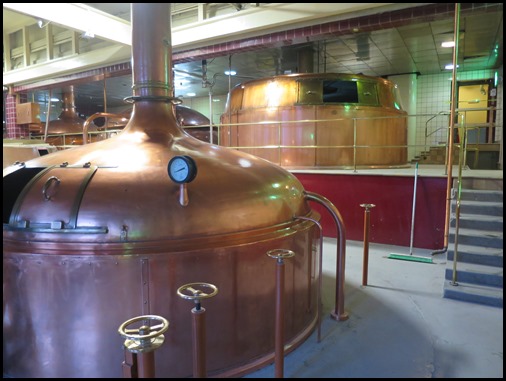      The Brew
Floor. The malt grist is combined with warm water on the way to the mash
mixer, through a “Steels Masher”. The result is a porridge like mixture called
“the mash”. The naturally occurring enzymes from the malt then convert the malt
starch into sugars, mainly maltose. This process takes approximately two hours
during which time the temperature is increased from the initial forty five
degrees to seventy five degrees Centigrade. After completion of mashing all
starch will have been converted to sugars. This is checked using the iodine
starch test. The mash is then transferred to the lauter.
The lauter is used to separate the
dissolved sugars from the insoluble remnants of the malt. The dissolved sugars
are known as “the wort”. Wort is run off the bottom of the lauter through the
malt husks and collected into the kettle. Hot water, also known as “hot liquor”,
is sprayed onto the top of the mash to rinse the sugars through. The malt husks
retained in the lauter are removed and used as cattle feed. Lautering takes two
to three hours.
The wort from the lauter is collected
into the kettle over a period of two to three hours. The volume of wort
collected is twenty four thousand litres at double strength. Wort is then boiled
for ninety minutes. During the boil, sugars and hops are added. The boiling
process performs several important functions:
Sterilisation of the
wort.
Added sugars are
dissolved.
Many flavour enhancing reactions take
place. Flavanoid formation and caramelisation occurs.
The hops added increase in
bitterness.
Protein out of the original malt
separates into flocs.
The malt enzymes are
inactivated.
The cooker is used as a holding
vessel for wort collecting from the days second brew, while the first brew is
still boiling in the kettle. It was originally installed to process – “cook”
other cereals such as rice, which can be used as a source of
starch.
There is another separation vessel.
The boiling wort from the kettle is rapidly transferred to the whirlpool in such
a way that the hot wort circulates. This circulation causes the “whirlpool
effect” where protein flocs formed in the kettle, settle to the base of the
vessel.
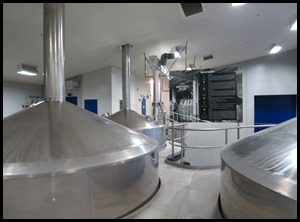 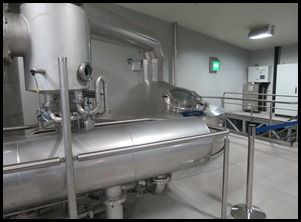  We moved from the traditional to the
new, sparkling stainless steel. Quicker, computer
operated but not as handsome.
Yeast is added to the wort which
converts the sugars into alcohol and carbon dioxide. The fermentation takes
about seven days to produce ‘green’ or unmatured beer. Towards the end of
fermentation yeast begins to settle to the bottom of the vessel. Once
fermentation is complete, the fermenter is cooled down to two degrees Centigrade
prior to the beer being transferred to the maturation tanks. All the carbon
dioxide produced is collected and reused at filtration to provide the
carbonation in the beer. The beer is cooled to zero. Dissolved carbon dioxide is
allowed to vent off the tanks, taking unpleasant sulphury compounds produced
during fermentation with it. Any yeast left will settle, these two processes
help get rid of the “green” flavour and allow easier filtration. Beer is then
typically stored between one to four weeks, depending on type.
Once the beer is matured, its
filtered. At Speight’s distomaceous earth is used in a vertical leaf bowser
filter of sand or diatom shells. The filter earth is deposited onto a wire mesh
support, which the beer is then passed through, on its way to the finished beer
tank - “bright beer” that is clear and sparkling and ready for racking into
kegs.
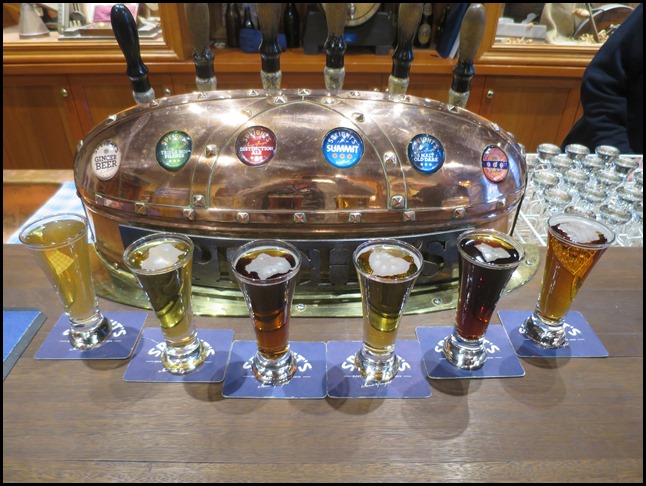 Tasting time. How much do they make - Twenty four million litres a year flow from this
plant.
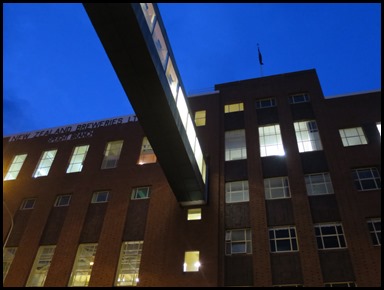 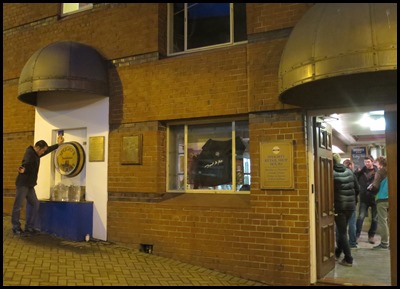 We bade our farewell and thank you.
Outside it was getting toward dusk. The bridge was lit
up, the last tour of the day assembled. We watched for a while and saw
many people come to fill all kinds of containers from the complementary tap –
sadly just bore water......... We’ll close
with our favourite advertisement – customer parking only.
 ALL IN ALL FASCINATING TO SEE
OLD AND NEW WORKING
AMAZING
HISTORY |